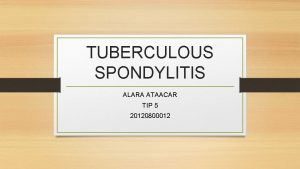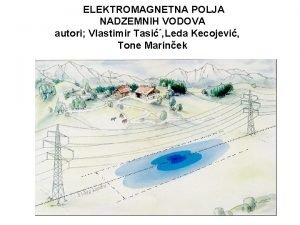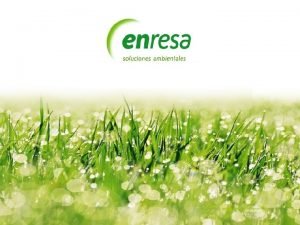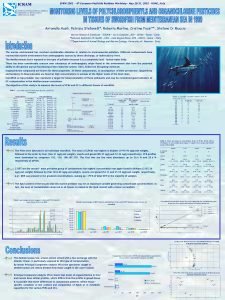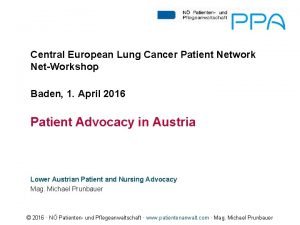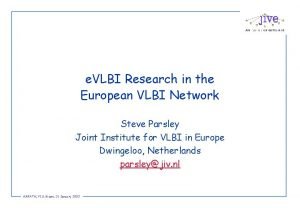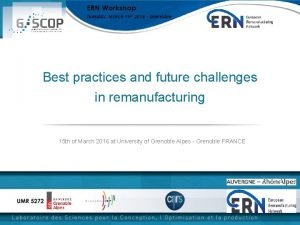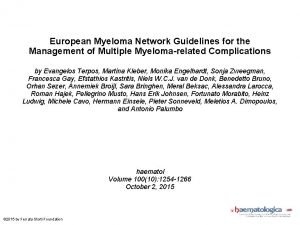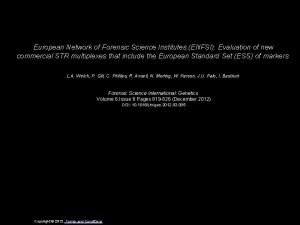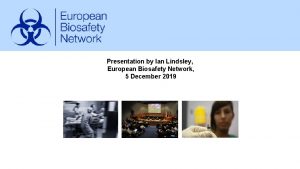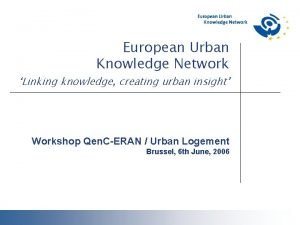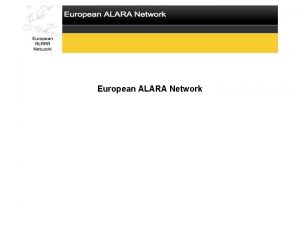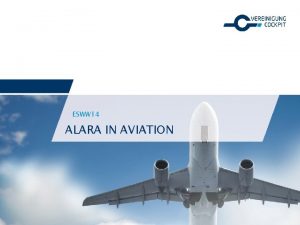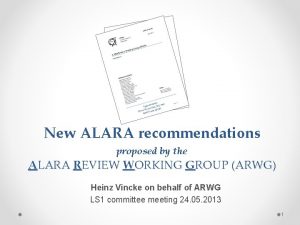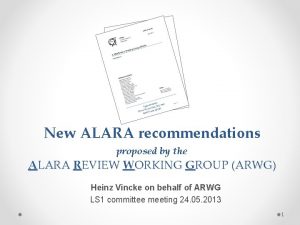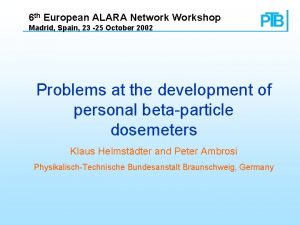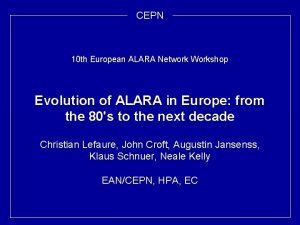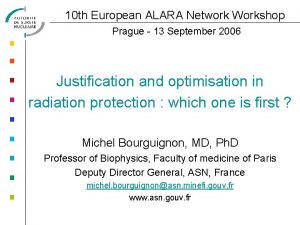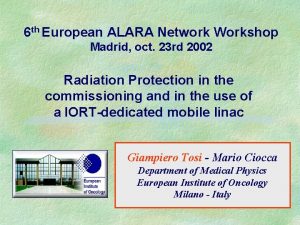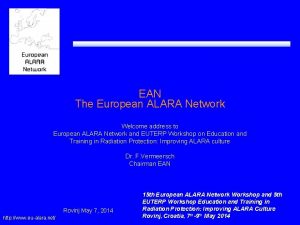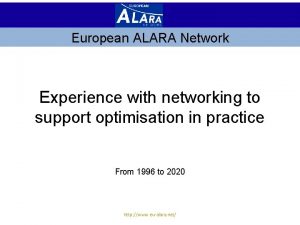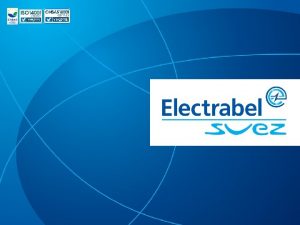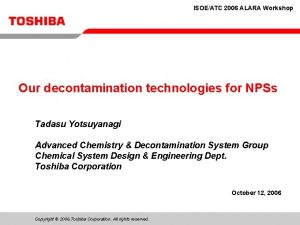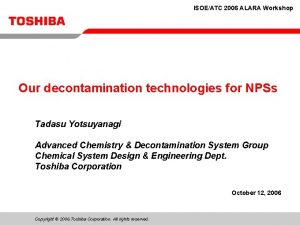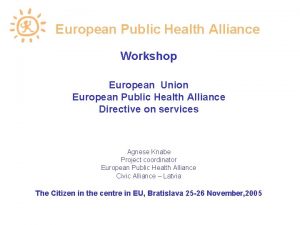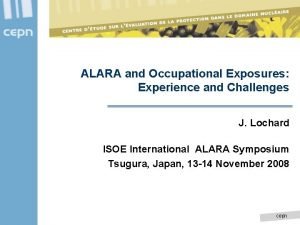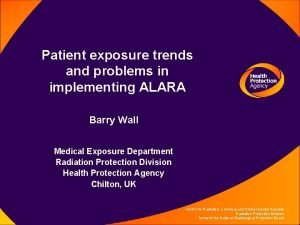15 th European ALARA Network Workshop and 5




















- Slides: 20

15 th European ALARA Network Workshop and 5 th EUTERP Workshop Education and Training in Radiation Protection Improving ALARA Culture 7 -9 May 2014, Rovinj, Croatia Greek Atomic Energy Commission initiatives with respect to education and training of outside workers C. Pafilis, M. Kalathaki, K. L. Karfopoulos, E. Carinou, S. Economides www. gaec. gr

Regulatory Requirements for E&T in Radiation Protection The Greek Radiation Protection Regulations: 1. 2. 3. 4. 5. All persons involved in radiological procedures must have knowledge on RP (theoretical and practical training). The competence of the personnel working in radiation facilities and activities must be checked before issuing (or renewing) the operation license of a facility Provisions for QE/RPE, RPO, MPE – recognition requirements GAEC issues certificates of competency on RP for occupationally exposed personnel (exams, cvs, personal interviews) GAEC recognizes syllabi on RP.

ISO 29990: 2010 An effective national programme on E&T in RP assumes that the E&T provider, has a well established Quality Management System (QMS). The ISO 29990: 2010 is • a generic model for quality professional practice and performance • a common reference for learning service providers in the: design, development and delivery of non-formal education

ISO 29990: 2010 The QMS adopted is oriented to the vision and the mission of GAEC while focuses on: Management Learning Services 4

ISO 29990: 2010 E&T services (i) Determine the learning needs (ii) Design the learning Service (e. g. learning outcomes, curriculum, teaching methods, teaching material, lecturers and participants criteria, exams) (iii) Provide the learning service (iv) Monitor delivery and evaluate of the learning service Learning Needs Evaluate E&T services Design Provide 5

Outside Workers ‘Outside worker’ means any exposed worker who is not employed by the undertaking (operator) responsible for the supervised and controlled areas, but performs activities in those areas, including, apprentices and students. ‘Outside Undertaking’ (employer) is considered any natural or legal person, other than the operator, including member of his staff, performing an activity of any sort in a controlled area. 6

Outside Workers Several issues have been raised with respect to outside workers involving: • the monitoring of their doses, and who is responsible for summing the doses received at different facilities and checking if the annual dose limits have been exceeded; • their education, training and information in radiation protection; • the localization of any possible overexposure. Regulatory Authorities Outside undertakings Operators Responsibility 7

Outside Workers • establish specific mechanisms for the reporting or authorization of the outside undertakings • ensure that the system for individual radiological monitoring affords outside workers equivalent protection to that for exposed workers employed on a permanent basis. Regulatory Authorities 8

Current situation in Greece • There are no nuclear facilities and outside workers provide their services mainly to public and private medical facilities ü Technicians performing the installation, maintenance and servicing of radiology, nuclear medicine and radiotherapy systems as well as the cyclotron installation ü Staff providing assistance during interventional procedures (pacemaker and stent positioning, orthopedics etc) ü Personnel undertaking the installation/replacement of radioactive sources • The outside undertakings must be licensed to allow their employees to provide services in controlled areas • GAEC in order to license the outside undertakings, performs on-site inspection at their installations to verify compliance with the existing requirements in terms of radiation protection ü If compliance is verified, GAEC issues a license which is valid for 5 years • During the on-site inspections at the installations of operators, GAEC ensures that the operators provide the required operational aspects of the radiation protection of outside workers that are directly related to the nature of their activities 9

Defining the Learning needs What they SHOULD know and do What they know and do Legislative framework On-site Inspections • • Directive 2013/59/Euratom Directive 90/641/Euratom Directive 80/836/Euratom Government Gazette, Ministerial Decision No. 9087(FOR) 1004: “Protection in practice of outside workers exposed to ionizing radiation during their activities in controlled areas” • Hellenic Radiation Protection Regulations 10

Defining the Learning needs What they SHOULD know and do What they know and do Legislative framework On-site Inspections • Some outside workers: ü Do not use their electronic dosemeter ü Own a radiation passport without having an electronic dosemeter ü Use their personal electronic dosemeter as survey meters ü Do not keep their radiation passport informed • • Directive 2013/59/Euratom Directive 90/641/Euratom Directive 80/836/Euratom Government Gazette, Ministerial Decision No. 9087(FOR) 1004: “Protection in practice of outside workers exposed to ionizing radiation during their activities in controlled areas” • Hellenic Radiation Protection Regulations 11

Defining the Learning needs What they SHOULD know and do What they know and do Legislative framework On-site Inspections • Some outside workers: ü Do not use their electronic dosemeter ü Own a radiation passport without having an electronic dosemeter ü Use their personal electronic dosemeter as survey meters ü Do not keep their radiation passport informed • Lack of appropriate training on RP as well as ALARA/Safety culture • • Directive 2013/59/Euratom Directive 90/641/Euratom Directive 80/836/Euratom Government Gazette, Ministerial Decision No. 9087(FOR) 1004: “Protection in practice of outside workers exposed to ionizing radiation during their activities in controlled areas” • Hellenic Radiation Protection Regulations 12

Defining the Learning needs What they SHOULD know and do What they know and do Legislative framework On-site Inspections • Some outside workers: ü Do not use their electronic dosemeter ü Own a radiation passport without having an electronic dosemeter ü Use their personal electronic dosemeter as survey meters ü Do not keep their radiation passport informed • Lack of appropriate training on RP as well as ALARA/Safety culture • The involved parties (undertakings, workers, operators) are unaware of the existing legislative framework or are not fully aware of roles and responsibilities • • Directive 2013/59/Euratom Directive 90/641/Euratom Directive 80/836/Euratom Government Gazette, Ministerial Decision No. 9087(FOR) 1004: “Protection in practice of outside workers exposed to ionizing radiation during their activities in controlled areas” • Hellenic Radiation Protection Regulations 13

Design of a training programme Parameters of the training programme • Duration: 8 hours • Educational level of participants: Secondary school at least • Lectures qualifications: ü GAEC has a pool of highly qualified and experienced lecturers (most of them are Medical Physicists) ü Cooperation with universities and research centers is always possible • • • A syllabus was decided Lesson plans were prepared Learning objectives: ü ü ü To be aware of the harmful effects of radiation To recognize radiation risks in workplace To adopt radiation protection ‘good practices’ To understand their role and responsibilities To develop a ‘safety culture’ 14

Syllabus 1. Fundamentals 4 h 1. 1 The physics of ionizing radiation 1. 2 Ionizing radiation detection systems 1. 3 Dosimetry 1. 4 Biological Effects of ionizing radiation 1. 5 Radiation Protection System The current legislative framework regarding outside workers Licensing procedure for outside undertakings 2. Practical aspects of Radiation Protection for outside workers 4 h 2. 1 Diagnostic and Interventional Radiology 2. 2 Nuclear medicine 2. 3 Radiotherapy Lesson plan example 15

Lesson Plan 2. 1 Diagnostic and Interventional Radiology Type Classroom based training Learning Outcome Basic awareness of the principles of radiation protection and the application of best practices in diagnostic and interventional radiology The participant will be able to do the following: • Apply basic concepts of radiation protection (i. e. the behavior of the factors of time, distance, shielding) • Apply practical methods for reducing doses • Be able to distinguish good from bad practices • Radiation Protection Principles Learning Objectives Content • • • (distance, time, shielding) Scattered radiation and leakage radiation Applying RP Principles – Best practices (control room, shielded doors, installation of new systems, lead apron, thyroid collar, glasses, personal dosimeter) Examples of RP bad practices Practices reducing the dose exposure of outside workers Accidents Duration 1 h Equipment Power Point, video projector Available Material Lecture Notes, Notebook (available via www. gaec. gr) 16

Provision of the programme • 3 seminars have been conducted ü 2 in Athens, 1 in Thessaloniki • 6 different lectures (Medical Physicists) • 60 outside workers out of 239 registered in the National Radiation Protection Database attended the seminars Thessaloniki [1] Athens [2] 17

Evaluation of the programme • Feedback from the participants by filling a questionnaire • Feedback from the lecturers by filling a questionnaire • Questions are related inter alia to the ü Structure of the seminar ü Presentations ü Learning objectives • Mean results >4. 5 for all the questions 18

Conclusions • The initiative taken was considered successful and that contributes significantly in the enhancement of the national radiation protection system and that supports the development of ALARA/Safety culture among the involved parties • Initiatives like this are going to be continued • More actions like distance learning courses, dissemination of informative material, continuous communication with related professional bodies should also be taken 19

Thank you very much for your attention!!! Greek Atomic Energy Agency P. O. Box 60092 Agia Paraskevi 15310, Athens T: 210 650 6700 F: 210 650 6748 E: info@eeae. gr www. facebook. com/eeaegr www. twitter. com/#eeaegr
 Alara dirik
Alara dirik Alara ataacar
Alara ataacar Alara şevket demirel ortaokulu
Alara şevket demirel ortaokulu Alara princip
Alara princip Alara facility management
Alara facility management European pesticide residue workshop
European pesticide residue workshop Gesundheit central european lung cancer patient network
Gesundheit central european lung cancer patient network European vlbi network
European vlbi network European creative hubs network
European creative hubs network European remanufacturing network
European remanufacturing network European myeloma network
European myeloma network Eban european business angels network
Eban european business angels network European network of forensic science institutes
European network of forensic science institutes Ian lindsley
Ian lindsley Launch27 themes
Launch27 themes Packet switching datagram and virtual circuit approach
Packet switching datagram and virtual circuit approach Features of peer to peer network and client server network
Features of peer to peer network and client server network Network centric computing
Network centric computing Topology in computer
Topology in computer Network systems design using network processors
Network systems design using network processors Packet vs circuit switching
Packet vs circuit switching

